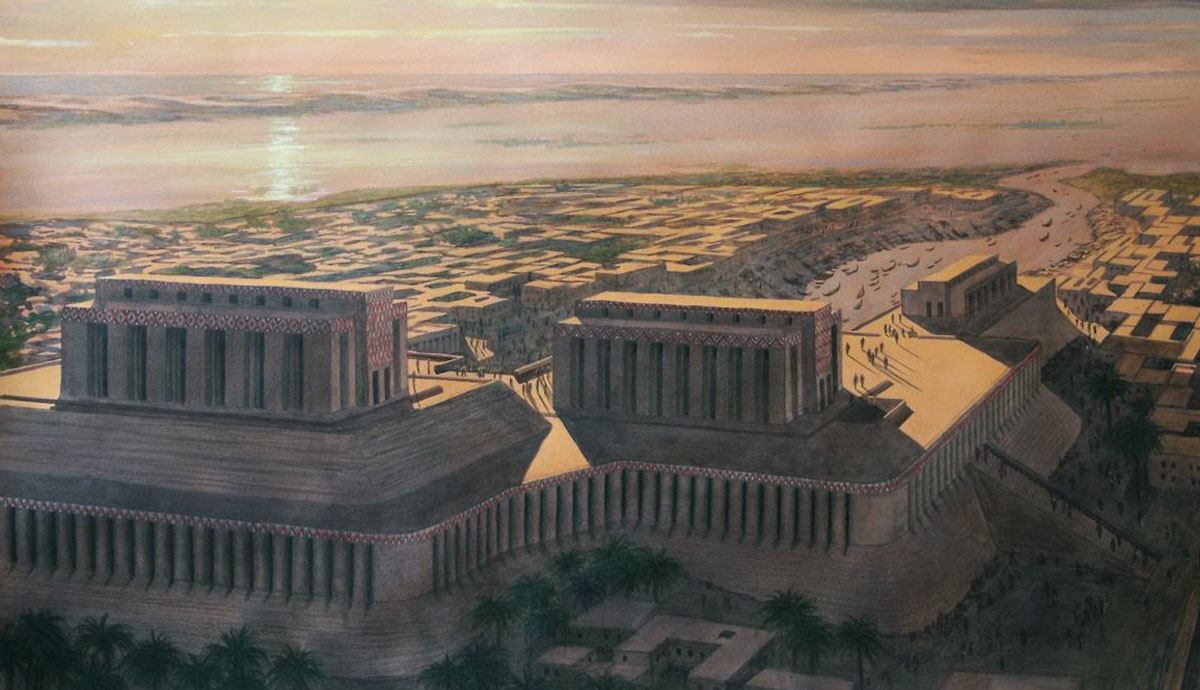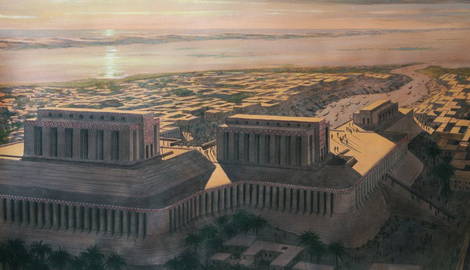
While Mesopotamia is widely regarded as the cradle of civilization, it is clear that civilization was happening long before the Sumerians built their cities along the Tigris and Euphrates. Human beings lived far and wide before the legendary civilizations of Sumeria and Egypt built their great empires.
These are some of the oldest cities that are still inhabited today. They came before the first civilizations and have outlived everything since.
1. Damascus, Levant: 10,000 BCE – 8000 BCE

Between 1963 and 1973, the site of Tell Ramad in modern-day Damascus was excavated. What they found was evidence of continuous Neolithic habitation and settlement that has been dated to be between 10,000 and 12,000 years old. Although these settlements do not qualify as a city, they do mean that Damascus and its surroundings have been inhabited for at least 10,000 years. This was corroborated by another site in the vicinity, Tell Aswad. This gives Damascus the title of being frequently named as the oldest continuously inhabited city in the world.
The culture here bore all the hallmarks of the Natufian culture, which was present in the Levant during the Neolithic and was responsible for a number of Neolithic settlements designed for permanent inhabitation. Houses were built using mud brick and stone, and the walls were plastered.
Tools were made of wood or stone, with obsidian tools originating in Cappadocia also being found. Like most sites in the Middle East, wheat and barley formed the backbone of agricultural efforts.
Habitation continued like this for thousands of years, with small settlements transitioning from the Neolithic to the Bronze Age. However, it wasn’t until the late Bronze Age that Damascus began to expand into a large city and play an important part in world history. It was the arrival of the Aramean people who kickstarted this period in Damascan history. This was when Damascus got its current name, or more precisely, “Dimashqu.” The Arameans constructed tunnels and canals, which were later improved by the Romans.

In the 9th century BCE, Damascus would clash with the Israelites before being completely conquered by the Neo-Assyrians, who saw little need to invest in the city. Damascus subsequently fell into a dark age before becoming subjects of the Babylonians in the 6th century BCE.
Damascus became part of the Persian Empire and was then conquered by Alexander the Great. After Alexander’s death in 323 BCE, the successor states of the Seleucid Empire and the Ptolemaic Empire battled for control of Damascus, and the city changed hands several times.
In 64 BCE, Damascus came under the control of the Romans. During this time, major works were constructed in the city, and after a few centuries, Damascus became a major metropolis. After the end of the Roman era, the Arabs took control. During the Umayyad period, the Grand Mosque of Damascus was constructed, finished in 715 CE. The structure still stands today and is one of the oldest mosques in the world.

The next few centuries saw Damascus under the rule of the Abbasids, the Seljuq Turks, the Ayyubids, the Mamluks, and then the Ottomans. Damascus was besieged and suffered at the hands of many conquerors, including the Crusaders and the Mongols.
In the 19th century, Damascus was under French control until 1946, when Syria gained full independence. In the 21st century, Damascus has been the site of conflict as an important location during the Syrian Civil War. Although the war has died down to sporadic skirmishes since the government forces took control of the vast majority of the country in 2017, Damascus continues to suffer the effects. From 2017 to 2022, it was awarded the ignominious title of being the least liveable city on Earth.
2. Ray/Rey, Media: 6000 BCE

Today there is a part of Tehran, Iran, called Ray. While it used to be a distinct city, it has now been absorbed by the urban sprawl of Iran’s capital city.
What is notable about Ray is the fact that it has been continuously inhabited since 6000 BCE. In the Neolithic era, agricultural settlements blossomed in the foothills around the modern site of Ray. These settlements were inhabited by people of the Central Plateau Culture. Not much changed for several thousands of years, as the people who lived there continued with their lives much the same as their ancestors had. Even throughout the Bronze Age, Ray did not feature as a significant entity.
It wasn’t until the Classical era that Ray started to play an important role in history. Under the Achaemenids/Persians, Ray played a central role in being the political and cultural base of the Medes, who formed a large and important role in the Persian Empire. After the defeat of Persia, the city came under the control of Alexander the Great and then the Seleucid Empire, at which time Ray was renamed Europos. In 148 BCE, the Parthians conquered Ray, and the city became known as Arsacia. For many decades, Ray formed a vital defensive purpose as a stronghold against nomadic attacks. It also served as one of the many capitals of the Parthian Empire.
Under the Sassanians, who succeeded the Parthians, Ray continued to be a noteworthy place, and it served as the seat of power of two of the seven most powerful houses in Iran and was an important site in the Zoroastrian religion.
During the Middle Ages, Ray was conquered and administered by the Arabs during and after the Muslim Conquests.

In the 11th century, Ray was captured and became an important regional capital within the Seljuk Empire. One of the major symbols of this era that survives today is the Tughrul Tower which serves as the tomb for the Seljuk ruler, Tughrul, who founded the Seljuk Empire.
During the 13th century, the town suffered extensive damage as a result of the Mongol invasions, and for a short time, Ray was abandoned in favor of the growing city of Tehran nearby.
From 1501, the Safavid Dynasty was in control of Persia, and although the historical fact is not clear at this time, the city of Ray seems to have been turned into a garden city. In 1618, the Italian author Pietro Della Valle wrote that the city was administered as a large garden but did not seem to be inhabited.
Ray was in ruins in the first half of the 19th century, but starting in 1886, a major restoration was undertaken. Around this time, the importance of Ray as an archeological site was acknowledged, and excavations began.
3. Argos, Greece: 5000 BCE

At the foot of Aspida Hill lies the city of Argos, an ancient place in the Peloponnese with a population of just over 20,000 people. It is widely regarded as the most ancient city in all of Greece, with a history stretching back 7,000 years.
Evidence points to a village in the area that dates back to 5000 BCE, but since the modern city covers much of the suspected areas of ancient habitation, archeological efforts have been severely hampered and limited.
Like all of Greece, Argos plays its part in myth and legend. It is first recorded as being named Phoronicon Asty, after its legendary founder Phoroneus. The first king of Argos is claimed to be Inachos, son of Oceanos and Tethys, who came from Egypt in 1876 BCE, just before the Mycenaean Period of ancient Greece.

Argos plays an important role in the ancient epics, being the birthplace of both Hercules and Perseus.
Because of its strategic location, Argos was a major stronghold and significant settlement during the Mycenaean era.
During the Archaic Period in Greek history, Argos was ruled by King Pheidon, who challenged Sparta for dominance. In 669 BCE, at the Battle of Hyssiae, the Argives defeated the Spartans, and as a result, Argos was the regional power for almost 200 years. During this time, the Argives expanded their influence over various parts of Greece and introduced many industries, such as pottery schools and tanneries.
In 494 BCE, the dominance of Argos was checked when the Spartans won a decisive victory against the Argives at the Battle of Sepeia. The growth of Argos after this slowed down, and the city was further isolated by the other Greek city-states following Argos’ refusal to join the league against Persia.
During the Peloponnesian War between Sparta and Athens, Argos joined in on the side of the Athenians but with lackluster commitment. In the following decades, Argos remained a minor power in ancient Greece.

Under the Romans, Argos prospered for a time, but by the last century of Roman rule, it was often targeted by Gothic and Heruli raiders. At the end of the 4th century CE, Argos, along with much of the rest of Greece, suffered significant damage from the conquest of Alaric, the Visigoth who later occupied Rome in 410 CE.
Centuries later, Argos would play a part in the Crusades and later be sold to Venice, which ruled the city until 1463, when it came under the control of the Ottoman Turks. Periods of conflict erupted throughout the following centuries, and Greek enmity towards the Turks grew, finally culminating in the Greek War of Independence in 1821, after which Argos became part of the Kingdom of Greece.
With its long and storied history, it is no surprise that Argos, much like the rest of Greece, is a tourist hotspot today.

The list of ancient cities still inhabited today is substantial but not exhaustive. Apart from Argos, other ancient cities that have a history that stretches back to before the bronze age and which are still inhabited include Jericho (10,000 BCE, very intermittently), Thebes (5000 BCE), and Athens (4000 BCE to 3000 BCE).
Other ancient cities include Girga in Egypt (3273 BCE) and Multan in the Punjab region in Pakistan (3000 BCE to 2800 BCE).
It is clear that what we currently know is only part of what is plausible. There are many cities that we know are ancient, but exactly how old they are remains a secret. Modern archeological finds are pushing back the time frame of when human beings first settled down and built cities, and the long history of humanity is continuously being rewritten as new discoveries are made that force us to rethink what we assumed to be fact. As such, there are cities inhabited today whose history could stretch back further than we ever imagined.










